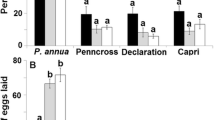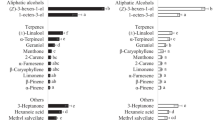Abstract
Behavioral studies using an olfactometer demonstrated that spring migrants of the damson-hop aphid,Phorodon humuli, respond to semiochemicals released by spring migrants feeding on hop leaves. Samples of the total volatiles released on feeding were analyzed by coupled gas chromatographysingle cell recording techniques and showed the presence of several active components. Three compounds were identified, using coupled gas chromatography-mass spectrometry, as methyl salicylate, (E)-2-hexenal andβ-caryophyllene. These three compounds elicited responses from separate olfactory receptors on the antenna. In the olfactometer, both (E)-2-hexenal andβ-caryophyllene gave positive responses from spring migrants, and a mixture of the two compounds in the natural ratio was more attractive than (E)-2-hexenal alone. Addition of methyl salicylate eliminated the response to the active binary mixture.
Similar content being viewed by others
References
Begon, M., Harper, J.L., andTownsend, C.R. 1986. Ecology, Individuals, Populations and Communities. Blackwell Scientific Publications, Oxford, pp. 203–000.
Blight, M.M. 1990. Techniques for isolation and characterization of volatile semiochemicals of phytophagous insects, pp. 281–288,in A.R. McCaffery and I.D. Wilson (eds.). Chromatography and Isolation of Insect Hormones and Pheromones. Plenum Press, New York.
Borden, J.H. 1989. Semiochemicals and bark beetle populations: exploitation of natural phenomena by pest management strategists, pp. 377–528,in N.C. Stenseth and L.R. Kirkendall (eds.). Population Dynamics of Bark Beetles, with Special Reference toIps typographus, Holarctic Ecology 12.
Campbell, C.A.M., Dawson, G.W., Griffiths, D.C., Pettersson, J., Pickett, J.A., Wadhams, L.J., andWoodcock, C.M. 1990. Sex attractant pheromone of damson-hop aphidPhorodon humuli (Homoptera, Aphididae).J. Chem. Ecol. 16:3455–3465.
Campbell, C.A.M.,Pettersson, J.,Pickett, J.A.,Wadhams, L.J., andWoodcock, C.M. 1993. Behavioural studies on the chemical ecology of the damson-hop aphid,Phorodon humuli (Homoptera, Aphididae). In preparation.
Chongrattanameteekul, W., Foster, J.F., andAraya, J.E. 1991a. Biological interactions between the cereal aphidsRhopalosiphum padi (L.) andSitobion avenae (F.) (Horn., Aphididae) on wheat.J. Appl. Entomol. 111:249–253.
Chongrattanameteekul, W., Foster, J.F., Shukle, R.H., andAraya, J.E. 1991b. Feeding behaviour ofRhopalosiphum padi (L.) andSitobion avenae (F.) (Horn., Aphididae) on wheat as affected by conspecific and interspecific interactions.J. Appl. Entomol. 111:361–364.
Dixon, A.F.G., andLogan, M. 1972. Population density and spacing in the sycamore aphid,Drepanosiphum platanoides (Schr.), and its relevance to the regulation of population growth.J. Anim. Ecol. 41:751–759.
Kay, R.H. 1976. Behavioural components of pheromonal aggregation inAphis fabae Scopoli (Horn., Aphididae).Physiol. Entomol. 1:249–254.
Kennedy, J.S., andCrawley, L. 1967. Spaced-out gregariousness in sycamore aphidsDrepanosiphum platanoides (Schrank) (Hemiptera: Callaphididae).J. Anim. Ecol. 36:147–170.
Pettersson, J. 1970. An aphid sex attractant. I. Biological studies.Entomol. Scand. 1:63–73.
Pettersson, J. 1993. The bird-cherry-oat aphid and odours,in Individuals, Populations and Patterns in Ecology. In press.
Pickett, J.A., andGriffiths, D.C. 1980. Composition of aphid alarm pheromones.J. Chem. Ecol. 6:349–360.
Pickett, J.A., Wadhams, L.J., Woodcock, C.M., andHardie, J. 1992. The chemical ecology of aphids.Annu. Rev. Entomol. 37:67–90.
Turchin, P., andKareiva, P. 1989. Aggregation inAphis varions: An effective strategy for reducing predation risk.Ecology 70:1008–1016.
Wadhams, L.J. 1990. The use of coupled gas chromatography: electrophysiological techniques in the identification of insect pheromones, pp. 289–298,in A.R. McCaffery and I.D. Wilson (eds.). Chromatography and Isolation of Insect Hormones and Pheromones. Plenum Press, New York.
Wadhams, L.J., Angst, M.E., andBlight, M.M. 1982. Responses of the olfactory receptors ofScolytus scolytus (F.) (Coleoptera: Scolytidae) to the stereoisomers of 4-methyl-3-heptanol.J. Chem. Ecol. 8:477–492.
Way, M. 1973. Population structure in aphid colonies, pp. 76–84,in Lowe (ed.). Perspectives in Aphid Biology. Entomological Society of New Zealand Bulletin No. 2,
Way, M., andCammel, M. 1970. Aggregation behaviour in relation to food utilization in aphids, pp. 229–247,in A. Watson (ed.). Animal Populations in Relation to their Food Resources. 10th Symposium B.E.S. 1969. Blackwell Scientific Publications, Oxford.
Author information
Authors and Affiliations
Rights and permissions
About this article
Cite this article
Campbell, C.A.M., Pettersson, J., Pickett, J.A. et al. Spring migration of damson-hop aphid,Phorodon humuli (Homoptera, Aphididae), and summer host plant-derived semiochemicals released on feeding. J Chem Ecol 19, 1569–1576 (1993). https://doi.org/10.1007/BF00984897
Received:
Accepted:
Issue Date:
DOI: https://doi.org/10.1007/BF00984897




